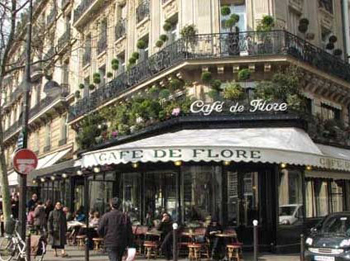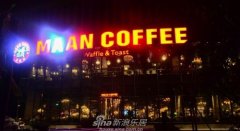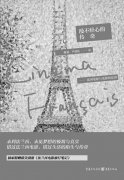Stroll through the Cafe Cafe in Paris to enlighten the art

Nurturing social trends and inspiring artistic inspiration
In Paris, the French capital, it is not difficult to find historical sites and cultural landmarks. Perhaps the small café next to you was once frequented by Picasso, Dali, Monet, Chopin, Voltaire and even Napoleon. Wandering among Paris's "celebrity cafes", France's splendid culture, art and history seem within reach.
Old coffee shops sell fame
Balzac, the great French writer who was good at writing about various social situations, once wrote: "The cafe counter is the parliament of the people." The French Revolution, Enlightenment, existentialism and other political, social and cultural trends of thought all moved from cafes to society. The Prokop Cafe is the oldest surviving cafe. It still retains its traditional, elegant decor. Its former regulars include Voltaire and Rousseau, the 18th-century European Enlightenment thinkers, and Diderot, author of the world's first encyclopedia, wrote works here that influenced the evolution of European and American revolutions and social development.
"Flower God" Cafe is one of the famous cafes in Paris, located on the left bank of the Seine River in Paris, surrounded by many universities and research institutes, opened in 1865, it is famous for receiving cultural and artistic circles. Picasso, Sartre, Breton and Trotsky all drank coffee there. Zhou Enlai often went to the Flower God for coffee and politics during his stay in France in the 1920s.
The café has a deep connection with literature, and even has literary scholarships, and reserves a special seat for the winners on the second floor for a year. A coffee cup engraved with the winner's name is always displayed in the café. Among the most famous guests were the existential masters Sartre and Beauvoir. To this day, the fixed table where they once sat over coffee and discussed academic issues remains a favorite among guests. In addition, Duras and Xu Zhimo, authors of the French novel Lover, often come here.
During the French Revolution, the cafes around the palace were places for political gatherings, and until the 20th century, they were the first places to discuss politics. It is said that Napoleon, before his rise, used his cap as collateral for his debts. In the 19th century, French art trends changed rapidly, and many famous cafes appeared around the Grand Opera House, such as the Café de la Paix, which was once the place where Bizet, Liszt, Chopin and others stayed. Some of the cafes in Montmartre Heights are meeting places for Picasso, Dali, Monet, Renoir and others.
A contest between large and small cups
When drinking coffee in Paris, you tend to feel that the waiter brings you a smaller cup than you would in other countries. It's not that Parisians are stingy, it's that you're worried about drinking too much coffee at once, because French people can drink a lot of coffee from morning to night, and the total amount is amazing. Some locals boasted to reporters that they could drink more than ten cups of coffee a day. According to historical records, Voltaire drank 70 cups of coffee a day at the Prokop Cafe.
With the change of times, the functions of restaurants and bars were combined with cafes, and later some cabaret performances began to enter cafes. In the 19th century, the phenomenon of combining cabarets and cafes began to appear: for example, the "Black Cat Cafe Cabaret" around Montmartre Heights was very popular. Since then, American coffee, Starbucks chain stores gradually "invasion" France, young people began to like the kind of large cup of coffee with cream, with a variety of flavors, while the old people continue to drink small cups of espresso Italian coffee.
Small coffee shop competition creativity
Because of their reputation, Paris's big-name cafes are also a bit more expensive. In the "Flower God" cafe, order a cup of the most ordinary coffee, but also for 5 euros, which is the price of two ordinary cafes. A cup of coffee costs nearly 9 euros at the Lilac Cafe, frequented by American writer Ernest Hemingway. To compete with celebrity cafes, peers next door sell ideas. The tables at Happy Hour are eye-catching: the red iron round coffee table is the size of a badminton racket and crowded for two cups of coffee. This is exactly the business philosophy of the cafe operators: drinking coffee here is about feeling alone. With creativity, it's always packed.
According to a tourism department survey, most people answered the question "What is the most attractive thing in Paris?" not the Louvre or the Eiffel Tower, but the cafes scattered around Paris.
Important Notice :
前街咖啡 FrontStreet Coffee has moved to new addredd:
FrontStreet Coffee Address: 315,Donghua East Road,GuangZhou
Tel:020 38364473
- Prev

Fall in love with the way coffee is run.
After searching in Haikou for a long time, I wanted to find a coffee shop with enough space. It's good to be delicate and compact, and so is the corner at the end of the alley, but not all cafes can accommodate my wayward sloppiness. Sometimes I will be afraid of the eyes of others, and sometimes I will be upset by the conversation at the next table. This girl is so capricious and needs a space irrationally. I met Manka when I went to the movies at the weekend.
- Next

Cafe and the movie "careless Legend"
The Seine, like an arc, winds its way through the city, dividing the whole of Paris into two parts, traditionally known as the left bank and the right bank. The Cabusina Avenue and Xiang Street mentioned earlier are located on the right bank. So, let's start with the right bank. In 1869, the Sisley family lived at No. 17 Huacheng at the foot of Montmartre Heights. Unlike the center of Paris overlooking the highlands, this 1860
Related
- How did the Salvadoran coffee industry develop in Central America?
- What exactly does the golden cup extraction of coffee mean?
- The Origin of Coffee flower
- [2023 Starbucks World Earth Day] there are more meaningful things besides free Starbucks coffee!
- What kind of coffee is there in Spain? 9 Flavors of Spanish Coffee
- Aromatic African coffee| Kenya's coffee culture and historical production area
- Liberica Coffee Bean knowledge: the characteristics of Liberian Coffee beans of the three original species of Coffee beans
- The origin and formula of Spanish latte introduces the taste characteristics of Bombon coffee in Valencia, Spain.
- How to adjust the solution of over-extracted coffee
- What is the tasting period of coffee beans? What is the period of coffee and beans? How should coffee wake up and raise beans?

